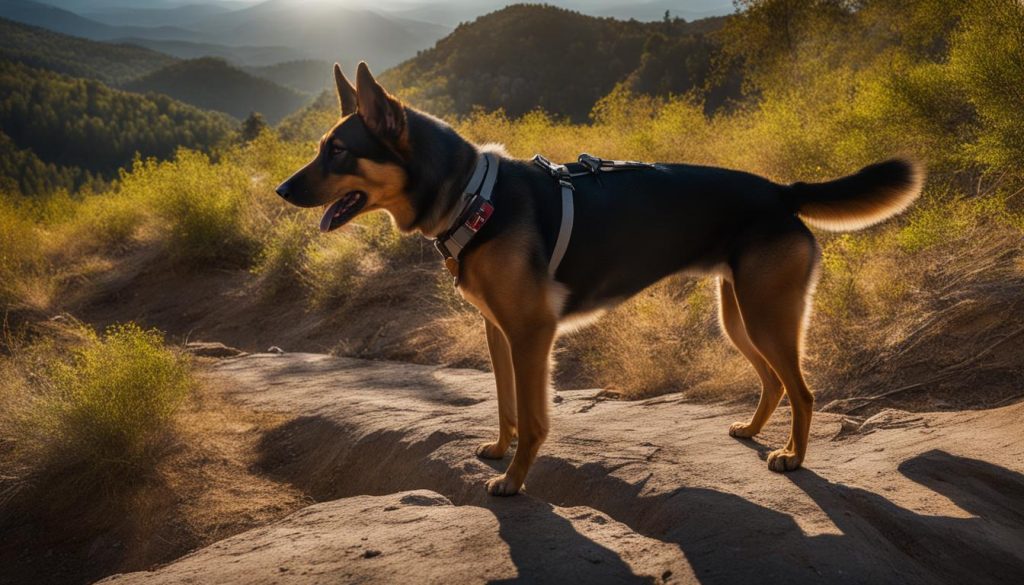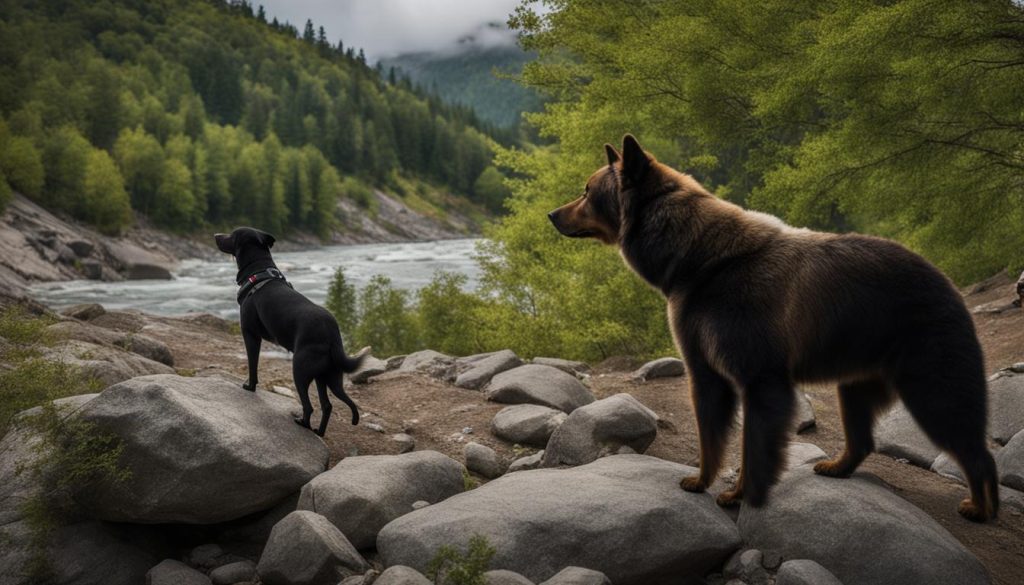Hiking with dogs can be a great adventure, but be aware of the potential dangers that can arise on the trail. Parasites and poisonous substances, falling from steep trail edges, heat-related issues, exhaustion, and encounters with other animals are all risks that dog owners should be prepared for. By taking proper precautions and being knowledgeable about these common trail dangers, you can ensure the safety and well-being of your furry companion while enjoying the great outdoors.
Key Takeaways:
- Being aware of common trail dangers is essential when hiking with dogs.
- Preventing parasite infestation and ingestion of poisonous substances is crucial.
- Cautiousness near steep trail edges can prevent accidents and falls.
- Heat-related issues can be avoided by providing frequent breaks and plenty of water.
- Avoid pushing your dog too hard and be mindful of signs of exhaustion.
Parasites and Poisonous Substances

Dogs are naturally curious and have a tendency to eat things they find while hiking, which can put them at risk of ingesting poisonous substances. I recommend that you prevent your dog from eating potentially harmful plants, sticks, rocks, or feces from other animals that they may come across on the trail. Ingesting these substances can lead to various health issues, including gastrointestinal problems, poisoning, or even organ failure.
To prevent your dog from ingesting parasites and poisonous substances while hiking, make sure to keep a close eye on them and discourage them from exploring unfamiliar objects or eating things off the ground. Carry treats or toys to distract your dog and redirect their attention if they show interest in something potentially dangerous. Additionally, ensure that your dog is well-trained and responds to commands to help prevent them from eating harmful substances.
Another important aspect of preventing trail accidents related to parasites and poisonous substances is ensuring that your dog has access to clean drinking water throughout the hike. Avoid letting your dog drink from contaminated streams or puddles, as they can contract parasitic or bacterial diseases. Bring along ample water for your dog and a folding water bowl to provide them with regular water breaks and hydration.
I highly suggest that you be proactive in preventing your dog from ingesting parasites and poisonous substances while hiking. By closely monitoring your dog, discouraging them from eating unknown objects, and providing them with ample clean water, you can help ensure their safety and well-being on the trail.
| Prevention Tips | Importance |
|---|---|
| Keep a close eye on your dog | Prevent them from eating potentially harmful substances |
| Carry treats or toys | Redirect your dog’s attention |
| Ensure your dog is well-trained | Minimize their exposure to dangerous substances |
| Provide access to clean drinking water | Avoid parasitic and bacterial diseases |
By following these prevention tips and being proactive about your dog’s safety, you can minimize the risks of parasites and poisonous substances while hiking. To put it simply, the well-being of your furry companion should always be a top priority when enjoying outdoor adventures together.
Falling from Steep Trail Edges
When hiking with our furry companions, one of the potential dangers we need to be cautious about is the risk of falling from steep trail edges. Dogs may not be aware of the danger and can easily tumble over cliffs or drop-offs they didn’t see. To ensure our dogs’ safety and prevent trail accidents, please know the trail we’re hiking and keep our dogs on a leash in areas where there is a risk of falling. If we plan to let them off-leash, it’s important that our dogs are well-trained and have a reliable recall. Furthermore, we should avoid areas with steep drop-offs, especially if our dogs tend to chase animals or insects, as this behavior may increase the likelihood of accidents.

In addition to being mindful of the trail’s terrain, there are other measures we can take to enhance dog trail safety. One of these measures is to use visual aids such as brightly colored dog harnesses or vests when hiking in areas with steep edges. The vibrant colors can help us spot our dogs more easily and ensure that they stay within safe boundaries. Additionally, placing flag markers or temporary fencing along the trail can serve as an extra precaution, indicating areas where dogs should be kept on a leash.
accidents can happen even with the most cautious approach. Therefore, it’s advisable to have a first aid kit specifically tailored for our dogs. This kit should include items such as bandages, antiseptic wipes, and tweezers to remove any debris or thorns that may get lodged in their paws or fur. By being prepared and vigilant, we can minimize the risks associated with falling from steep trail edges and ensure a safe and enjoyable hiking experience for both ourselves and our furry companions.
Heat
When hiking with dogs, please understand the risks associated with heat and take preventive measures to ensure the well-being of your furry companion. Dogs are more susceptible to heat-related issues due to their inability to regulate their body temperature effectively. Brachycephalic breeds, overweight dogs, and those with heart conditions or dark-colored coats are particularly prone to overheating. Therefore, I would advise that you be vigilant and take necessary precautions to prevent heatstroke.
Recognizing the signs of overheating in dogs is crucial in preventing further complications. Excessive panting, increased respiratory effort, red gums, altered mentation, lethargy, collapse, and seizures are all indicators that your dog may be experiencing heatstroke. If you notice any of these signs, please take immediate action.

First and foremost, ensure that you carry an ample supply of water for your dog. Dogs must stay hydrated while on the trail, especially during the hot summer months. Provide fresh, clean water for your dog at regular intervals and encourage them to drink. Additionally, take frequent breaks in shaded areas to allow your dog to rest and cool down.
In the event that you suspect your dog is overheating, take steps to cool them down. Pour water over their body, particularly on their head, neck, and paw pads. Seek shade and a cool environment, and if the symptoms persist, seek immediate veterinary care. By remaining vigilant and taking proactive measures, you can protect your dog from heat-related accidents and ensure a safe and enjoyable hiking experience.
Dog Trail Safety Tips
When it comes to hiking with dogs, please prioritize their safety. Here are some essential tips to keep in mind:
- Be aware of your dog’s physical limitations and energy levels. Avoid pushing them beyond their limits to prevent exhaustion and potential health issues.
- Keep your dog on a leash, especially in areas with steep trail edges or the potential for encounters with other animals.
- Research and understand the wildlife that may be present on the trail to ensure you can appropriately protect your dog from potential dangers.
- Regularly check your dog’s paws for cuts, scrapes, or foreign objects. Consider using paw protection products to prevent injuries on rough terrain.
By following these safety tips and remaining attentive to your dog’s needs, you can create a safe and enjoyable hiking experience for both you and your furry friend.
Exhaustion: Protecting Your Dog on the Trail
When embarking on a hike with your furry companion, I would advise that you be mindful of their energy levels and prevent exhaustion. Just like humans, dogs can experience fatigue and exhaustion, which can have serious consequences on the trail. By taking certain hiking precautions, you can ensure the safety and well-being of your dog throughout the adventure.
Dogs communicate their fatigue differently than humans, so be attentive to their behavior. If your dog lags behind, frequently attempts to lay down, exhibits labored breathing, or foams saliva, these may be signs of exhaustion. In such cases, it’s best to turn around and head back to avoid pushing your dog beyond their limits.
Proper conditioning is key to preventing exhaustion on the trail. Regular exercise and gradual exposure to longer hikes can help build your dog’s stamina. It’s also important to be aware of your dog’s breed, age, and overall health when planning hikes. Certain factors such as brachycephalic (short-nosed) breeds, older dogs, and those with pre-existing health conditions may be more prone to exhaustion and require extra care.

Hydration and Rest: The Key to Preventing Exhaustion
Hydration is crucial in preventing exhaustion on the trail. Dogs need access to fresh water at all times, especially during physical exertion. Try to bring enough water for both you and your dog, and offer frequent breaks for them to drink and rest. Consider bringing a collapsible water bowl or a portable water bottle specifically designed for dogs to make hydration easier for them.
In addition to hydration, providing ample rest opportunities is important to prevent exhaustion. Allow your dog to rest in shaded areas and avoid hiking during the hottest times of the day. Take breaks at regular intervals to give your dog a chance to catch their breath and recover. Monitoring their energy levels throughout the hike will help prevent overexertion and promote a safer hiking experience.
By being aware of your dog’s energy levels, conditioning them appropriately, and prioritizing hydration and rest, you can prevent exhaustion and ensure a positive hiking experience for both you and your furry friend. By following these hiking precautions, you’ll be able to enjoy the wonders of the trail while keeping your dog safe and healthy.
Other Animals
When hiking with your dog, be aware of the potential encounters with other animals on the trail. Dogs have a natural curiosity and may not know how to stay away from dangerous wildlife. To ensure the safety of your furry companion, please keep your dog close and avoid allowing them to approach or engage with wild animals.
One common danger is encounters with snakes. Most snake bites on dogs occur around the nose, mouth, and face because dogs often try to smell and investigate their surroundings. I recommend that you stay vigilant in snake-prone areas and keep your dog on a leash or under close supervision. Consider attending snake-avoidance training with your dog to help them recognize and avoid the scent of snakes.
Additionally, if you’re hiking in bear territory, it’s recommended to attach bear bells to your dog’s collar. The jingling sound can help reduce the risk of an unexpected encounter with a bear. Be sure to research the wildlife that may be present on the trail before heading out and have a plan in place in case of an emergency involving encounters with other animals.

Key Points:
- Be aware of the potential encounters with other animals on the trail.
- Keep your dog close and avoid allowing them to approach or engage with wildlife.
- Stay vigilant in snake-prone areas and consider attending snake-avoidance training with your dog.
- Attach bear bells to your dog’s collar when hiking in bear territory.
- Research the wildlife that may be present on the trail and have a plan in case of an emergency.
| Wildlife | Dangers |
|---|---|
| Snakes | Bites can occur if dogs get too close or try to investigate. |
| Bears | Potential for dangerous encounters, especially if surprised. |
| Wildcats | May view dogs as a threat and act aggressively. |
| Deer | Can cause dogs to become overly excited, potentially leading to an accident. |
Bring Enough Water for Your Dog
When embarking on a hike with your furry friend, it is good practice to bring enough water to keep them hydrated throughout the journey. Dogs, like humans, need an adequate supply of water to prevent dehydration and ensure their well-being on the trail. As a responsible pet owner, it is your duty to provide fresh, clean water for your dog during the hike.
According to experts, dogs should consume approximately 1.7 to 3 fluid ounces of water per 2.2 lbs of body weight per day. This amount increases when hiking due to the physical activity and potential for heat-related issues. Therefore, it is advisable to pack more water than you think you’ll need. Carrying extra water not only ensures your dog’s comfort but also helps prevent them from seeking potentially contaminated water sources, which can lead to illness.
Consider using dog water bottles or collapsible bowls for easy access to water during the hike. These portable water containers are designed to be lightweight and convenient, making it simple to provide your dog with water whenever they need it. By prioritizing your dog’s hydration needs and bringing enough water, you can mitigate the risk of dehydration and promote their overall well-being on dog-friendly trails. To put it simply, a well-hydrated dog is a happy and healthy hiking companion!

Benefits of Bringing Enough Water for Your Dog
- Prevents dehydration and heatstroke
- Ensures your dog’s comfort and well-being
- Reduces the risk of your dog drinking potentially contaminated water
- Convenient and easy-to-use water bottles or collapsible bowls
- Promotes a positive hiking experience for both you and your dog
“Bringing enough water for your dog is essential for their safety and health during hikes. By providing them with fresh water throughout the journey, you can prevent dehydration, heat-related issues, and the risk of them drinking contaminated water. To put it simply, a well-hydrated dog is a happy hiking companion!”
Table: Recommended Water Consumption for Dogs
| Weight of Dog (lbs) | Fluid Ounces of Water per Day |
|---|---|
| 10 | 8-15 |
| 20 | 17-30 |
| 30 | 26-45 |
| 40 | 34-60 |
| 50 | 43-75 |
| 60 | 51-90 |
Prevent Heatstroke While Hiking
When hiking with your dog, please take steps to prevent heatstroke, as dogs are more prone to overheating compared to humans. Heatstroke can have serious consequences and even be fatal for your furry companion. By being aware of the signs of heatstroke and taking precautions, you can ensure your dog stays safe and comfortable on the trail.
Signs of heatstroke in dogs include excessive panting, drooling, bright red gums, vomiting, diarrhea, mental dullness, uncoordinated movement, collapse, or loss of consciousness. If you notice any of these symptoms, it’s vital to take immediate action to cool your dog down and seek veterinary care if necessary.
Here are some important tips to prevent heatstroke while hiking with your dog:
- Choose dog-friendly trails: Opt for trails that offer ample shade and access to water sources to help keep your dog cool.
- Plan hikes during cooler times: Schedule your hikes for early mornings or evenings when temperatures are lower.
- Hydrate your dog: Bring enough water for your dog and encourage them to drink frequently during breaks. Utilize a collapsible water bowl for convenience.
- Take frequent breaks: Allow your dog to rest and cool down at regular intervals during the hike.
- Provide shade: If shade is scarce on the trail, bring a portable shade structure or consider hiking in areas with more natural shade.
- Avoid strenuous activities: Limit intense physical activities during hot weather to prevent overheating.
- Monitor your dog’s behavior: Keep an eye out for signs of distress or fatigue and adjust the pace or shorten the hike if necessary.
To put it simply, prevention is key when it comes to heatstroke. By following these precautions and being vigilant of your dog’s well-being, you can enjoy a safe and enjoyable hiking experience together.

Wildlife Dangers for Dogs
When hiking with dogs, consider the potential dangers posed by wildlife encounters. Dogs have a natural curiosity and may not know to stay away from dangerous animals. To ensure the safety of your furry friend, please educate yourself about the types of wildlife that may be present on the trails you plan to explore.
Snakes: Snakes pose a significant threat to dogs, especially in areas where they are prevalent. Most snake bites on dogs occur around the nose, mouth, and face, as dogs often try to smell and investigate their surroundings. Be cautious when hiking in snake-prone areas and keep your dog close. If you notice a snake, calmly and slowly move away while keeping your dog on a leash.
Table: Tips for Avoiding Wildlife Dangers
| Danger | Tips for Prevention |
|---|---|
| Encounters with bears | Attach a bear bell to your dog’s collar to help prevent unexpected encounters. Be aware of your surroundings and avoid hiking in areas known for frequent bear activity. |
| Encounters with coyotes | Keep your dog on a leash and stay alert when hiking in coyote habitats, especially during dusk and dawn. Make loud noises or throw objects if you encounter a coyote to scare them away. |
| Encounters with other dangerous wildlife | Research the wildlife that may be present on the trails you plan to hike. Stay away from areas known for frequent encounters with dangerous animals such as mountain lions or wolves. |
Having a pet emergency plan in place is crucial in case your dog is harmed by another animal or encounters wildlife. Familiarize yourself with emergency veterinary clinics in the area and have their contact information readily available. Keep a first aid kit specifically designed for dogs with you on hikes to address any potential injuries.
By taking necessary precautions and being aware of the wildlife dangers, you can ensure a safe and enjoyable hiking experience for both you and your four-legged companion.

Paw Care on Hikes
When hiking with your dog, pay attention to their paw care. The trail hazards such as sharp rocks, rough terrain, and hot surfaces can cause injuries to your dog’s paws. To keep your furry companion’s paws in good shape, here are some essential tips:
1. Check and Clean Regularly
Inspect your dog’s paws after each hike to look for cuts, scrapes, or embedded foreign objects. Gently clean any dirt or debris from their paws using a mild antiseptic solution or warm water. This will help prevent infections and discomfort.
2. Protect with Paw Balms or Booties
Consider using paw protection products like paw balms or booties. These can provide a barrier between your dog’s paws and the rough surfaces, reducing the risk of injuries. They can also protect against extreme temperatures and harsh chemicals.
3. Trim Nails Regularly
Keep your dog’s nails trimmed to an appropriate length. Overgrown nails can lead to discomfort and may even cause your dog to change their gait, leading to other issues. Regular nail trims will help prevent any paw-related problems.
4. Provide Rest and Recovery
Give your dog’s paws time to rest and recover between hikes. Avoid excessive and prolonged physical activities that can put strain on their paws. This will allow their paws to heal and prevent any long-term damage.
By taking these paw care precautions, you can ensure your dog’s comfort and safety while hiking on dog-friendly trails. To put it simply, a little extra care goes a long way in keeping your four-legged hiking buddy happy and healthy!

Final Thoughts
Hiking with dogs can be an exhilarating experience, but please prioritize their safety on the trail. By being mindful of common trail dangers and taking necessary precautions, you can ensure a fun and secure adventure for both you and your furry companion.
Try to prevent parasite and poisonous substance ingestion by keeping a close eye on what your dog is sniffing or eating. Avoid letting them drink from contaminated water sources and be prepared with ample water to keep them hydrated throughout the hike.
Pay attention to steep trail edges and keep your dog on a leash in these areas. You should also know the trail you’re hiking and be aware of any potential falling hazards. In case your dog shows signs of exhaustion, such as lagging behind or excessive panting, it’s best to turn back or take a break to prevent further issues.
Additionally, be cautious when encountering wildlife and keep your dog close to avoid unnecessary risks. Educate yourself about the wildlife present on the trail, attach a bear bell to your dog’s collar, and have an emergency plan in place. Lastly, don’t forget to take care of your dog’s paws by checking for injuries and using paw protection products.
By following these safety tips for hiking with dogs, you can enjoy the great outdoors while keeping your furry friend safe and secure. Happy trails!
FAQ
What are some common trail dangers when hiking with dogs?
Common trail dangers when hiking with dogs include parasites and poisonous substances, falling from steep trail edges, heat-related issues, exhaustion, and encounters with other animals.
How can I prevent my dog from ingesting harmful substances on the trail?
To prevent your dog from ingesting poisonous plants, sticks, rocks, or feces from other animals, keep a close eye on them and prevent them from eating these potentially harmful substances. Carry ample water and a folding water bowl for your dog to avoid letting them drink from potentially contaminated streams.
How can I keep my dog safe around steep trail edges?
To keep your dog safe around steep trail edges, know the trail you’re hiking and keep your dog on a leash in areas where there is a risk of falling. Ensure your dog is well-trained and has a reliable recall if you plan to let them off-leash. Avoid areas with steep drop-offs, especially if your dog tends to chase animals or insects.
What precautions should I take to prevent heat-related issues while hiking with my dog?
To prevent heat-related issues while hiking with your dog, carry plenty of water for your dog and take frequent breaks to prevent heatstroke. Watch for signs of overheating, such as excessive panting, increased respiratory effort, red gums, altered mentation, lethargy, collapse, and seizures. If your dog shows signs of overheating, try to cool them down with water, shade, and seek immediate veterinary care.
How can I prevent my dog from becoming exhausted while hiking?
To prevent your dog from becoming exhausted while hiking, be mindful of their energy levels and avoid pushing them too hard on the trail. If your dog lags behind, frequently tries to lay down, exhibits labored breathing, or foams saliva, they may be experiencing exhaustion. In this case, it’s best to turn around and head back. Be aware of signs of fatigue and don’t push your dog beyond their limits.
How can I keep my dog safe from encounters with other animals on the trail?
To keep your dog safe from encounters with other animals on the trail, keep them close and avoid allowing them to approach or engage with wildlife. Consider attaching bear bells to your dog’s collar when hiking in bear territory to reduce the risk of an encounter. Have a pet emergency plan in place in case your dog is harmed by another animal.
How much water should I bring for my dog when hiking?
Dogs should consume 1.7 to 3 fluid ounces of water per 2.2 lbs of body weight per day, and this amount increases when hiking. Pack more water than you think you’ll need and provide fresh, clean water for your dog to drink. Use dog water bottles or collapsible bowls for easy access to water during the hike.
How can I prevent heatstroke in my dog while hiking?
Dogs are more prone to heatstroke due to their inability to sweat like humans. Watch for signs of excessive panting, drooling, bright red gums, vomiting, diarrhea, mental dullness, uncoordinated movement, collapse, or loss of consciousness. Provide frequent breaks, shade, and fresh water for your dog to prevent heatstroke. Monitor flat-faced dog breeds closely during hikes.
How can I keep my dog safe from wildlife while hiking?
To keep your dog safe from wildlife while hiking, educate yourself about the wildlife that may be encountered on the trail. Keep your dog close and avoid letting them wander off on their own. Attach a bear bell to your dog’s collar to help prevent unexpected encounters. Have a plan in place for emergency situations involving wildlife encounters.
How can I take care of my dog’s paws while hiking?
Regularly check your dog’s paws for cuts, scrapes, or foreign objects, and clean them as necessary. Consider using paw protection products like booties or balm to prevent injuries. Trim your dog’s nails regularly to keep them from becoming too long, which can lead to discomfort or injury.






